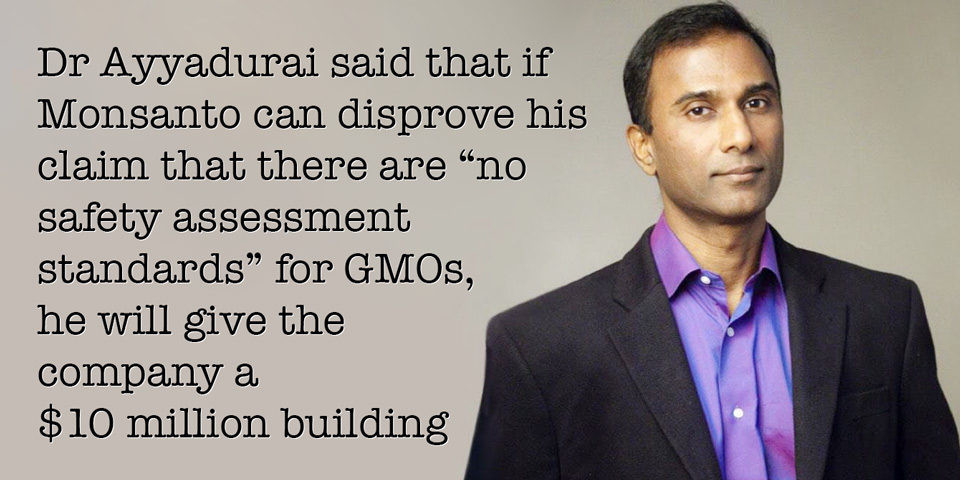
If company can disprove Shiva Ayyadurai’s statement that there are “no safety assessment standards” for GMOs, he will give it a $10 million building – exclusive interview by GMWatch
GMWatch has had several inquiries about the challenge issued to Monsanto by systems biologist Dr Shiva Ayyadurai. In an interview with Patch.com, Dr Ayyadurai said that if Monsanto can disprove his claim that there are “no safety assessment standards” for GMOs, he will give the company a $10 million building that he owns in Cambridge, Massachusetts.
Dr Ayyadurai is the lead author of four papers that used a computational systems biology approach to analyse the effects of the genetic engineering process on key biochemical pathways affecting plant physiology. The results predicted that the carcinogen formaldehyde could accumulate in the GM soybean plants, with concomitant depletion of the antioxidant glutathione, but not in the non-GM plants.
We asked Dr Ayyadurai to tell us more about his challenge to Monsanto.
GMW: You said “there are no safety assessment standards for GMOs”. But here in Europe we do have safety assessments for GMOs, albeit they are weak.
Dr Ayyadurai: I’m talking about standards for testing the material difference or equivalence of GMO vs. non-GMO. A claimed lack of difference is used to assert that GMOs are “substantially equivalent” to non-GMOs and therefore safe. But objective standards to measure equivalence or difference do not exist. This is explained in the conclusion of my paper, “Do GMOs accumulate formaldehyde and disrupt molecular systems equilibria? Systems biology may provide answers”.
GMW: Do you think you need to clarify your meaning to Monsanto? Otherwise they could cite safety assessment requirements in one country to prove that they exist – and claim your $10 million building!
Dr Ayyadurai: I think in the context of the research we just completed, it’s quite clear what we mean. We are talking about standards, not “requirements”. A standard provides rigorous protocols, processes and procedures: for example, what ingredients should be in the soil and what kind of chemical assay should be done to measure whether that GMO is “materially different” from, or “substantially equivalent” to, its non-GMO counterpart. More importantly, any independent lab should be able to execute those standards, so the results would be reproducible, not just behind closed doors at Monsanto or by a university professor they have funded.
GMW: Your papers use computational systems biology to predict that formaldehyde could accumulate in GM soy plants. Why didn’t you test some to see if the prediction was true?
Dr Ayyadurai: An important point related to this question is that our predictions are not “just a model” we made up using mathematics. The research is based on amalgamating the molecular pathway interactions derived from 6,497 actual wet lab tests, conducted across 184 institutions in 23 countries. The systems biology method integrates those pathway interactions to develop a whole systems understanding of the effects of genetic modification.
We definitely want to do testing to validate the predictions, but it’s difficult. First, as we explain in our paper, it is difficult to obtain the research materials – the GM and non-GM crops grown side-by-side in the same conditions – in an objective and independent manner, while ensuring legal compliance. We are actually in the midst of trying to get samples. The second reason is that, given the current environment, any testing done by either proponents or opponents of GMOs will be contested since there are no agreed standards for conducting such testing to compare a GMO with its non-GMO counterpart.
GMW: Isn’t your challenge to Monsanto just a publicity stunt?
Dr Ayyadurai: The difference or equivalence between GMOs and their non-GMO counterparts goes to the heart of the GMO safety issue. This challenge aims to bring the issue forward in a manner that helps the public and scientists to see it clearly. If anything, Monsanto has been doing publicity stunts by paying off academics, while spending tens of millions in advertising to brainwash us with beautiful images of African and Indian children frolicking in open fields of flowers, etc., to make us believe that GMOs are safe, while manipulating mainstream media to claim that safety standards for GMOs exist and that the organizations such as the US FDA have determined and assessed the safety of GMOs in the market. This is not true; thus, the challenge.










